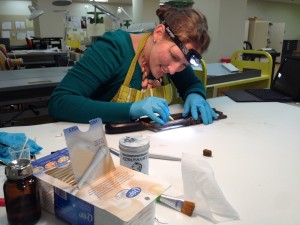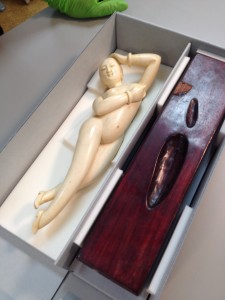Duke Today has a new story out about the collaborative work that staff from Conservation, the Rubenstein Library History of Medicine Collection, and the Shared Materials Instrumentation Lab are doing to house, scan, and eventually 3-D print our ivory manikins. Check out the story here. And watch this very cool video of the process.
Tag Archives: history of medicine
Hosting a Contract Conservator On Site
Recently we contracted with object conservator Susanne Grieve Rawson to work on some objects from the History of Medicine Collection. These are being prepared for exhibit in the renovated Rubenstein Library.
Rather than sending her the objects as you normally do when you contract conservation services, Susanne came to the Verne and Tanya Roberts Conservation Lab to do the work.
Susanne started the first day evaluating the condition of the objects with Rachel Ingold, History of Medicine Collection curator, and Meg Brown, Exhibits Coordinator. Her examination included looking at a few of the objects under UV light.
She also met with Rachel and Andrew Armacost, Head of Collection Development in the Rubenstein Library, to discuss the condition of the items and potential treatment options.
|
|
Susanne brought an amazing kit of tools with her. We geeked out a little, asking her questions about the special tools and supplies she had. It was a fun and educational to have an outside contractor working in the lab. We learned a lot from each other. I hope we have this opportunity again.
Quick Pic: It Should Be Halloween
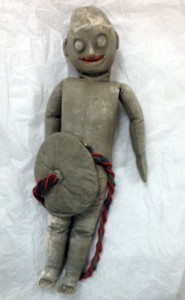
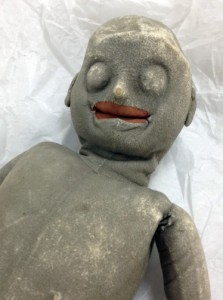 We got an amazing History of Medicine Collection artifact in the lab today for boxing . It is an anatomical birthing model dated to the 1890’s. The body and placenta are made of a soft suede material with red and blue yarn for the umbilical cord. The stitching that attaches each section to the main body is very finely done.
We got an amazing History of Medicine Collection artifact in the lab today for boxing . It is an anatomical birthing model dated to the 1890’s. The body and placenta are made of a soft suede material with red and blue yarn for the umbilical cord. The stitching that attaches each section to the main body is very finely done.
I don’t know the complete history of this item. But judging by the attention to detail on the hands, feet, and ears, along with the elegant stitching, you can tell this was a lovingly-crafted model.
Quick Pic: Boxing Near-Naked Ladies
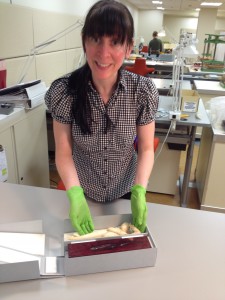 Every now and then something really, really great comes to the lab for a custom enclosure. We have been working on high priority items in anticipation of the Rubenstein Library move to its renovated space this fall.
Every now and then something really, really great comes to the lab for a custom enclosure. We have been working on high priority items in anticipation of the Rubenstein Library move to its renovated space this fall.
On Rachel’s bench is one of the ivory manikins from the History of Medicine Collection. This one is lounging on a beautifully carved-out wooden bed. I love that the manikin is wearing shoes. Very modest indeed.
Happy Fifth Birthday to Devil’s Tale!
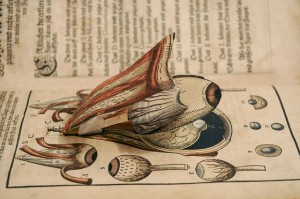
Image from Ophthalmodouleia, das ist Augendienst… by George Bartisch. Published in 1583, this item was on display for the Animated Anatomies exhibit.
Photo by Mark Zupan, Senior Graphic Designer for Duke University Libraries.
Today marks the fifth birthday of our sister blog The Devil’s Tale.
Happy birthday Devil’s Tale, and may you post many more eye opening dispatches from the Rubenstein Rare Book and Manuscript Library.
1091 Project: From Art To Eyeballs
 This month on the 1091 Project we are highlighting the non-book, non-paper items that come to the conservation lab for evaluation and rehousing. In our collections we have the usual amounts of prints, drawings, paintings and various other kinds of artwork. But we also have hanks of famous-people’s hair, pink felt dragons, christening gowns, weather vanes, plaster death masks, roll-playing figurines, shaving mugs, poison arrows…you name it, we likely have it. We have several items in the lab right now that fall into this category.
This month on the 1091 Project we are highlighting the non-book, non-paper items that come to the conservation lab for evaluation and rehousing. In our collections we have the usual amounts of prints, drawings, paintings and various other kinds of artwork. But we also have hanks of famous-people’s hair, pink felt dragons, christening gowns, weather vanes, plaster death masks, roll-playing figurines, shaving mugs, poison arrows…you name it, we likely have it. We have several items in the lab right now that fall into this category.
In The Lab For Enclosures
Our History of Medicine Collection provides endless challenges including these hand-blown glass eyeballs. They are so lovely and delicate, and a little creepy (the eyes seem to follow you like the Picture of Dorian Grey).
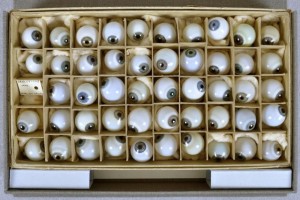
Also from HOM is this 18th Century screw-barrel microscope in a shagreen (skate skin) case. We just started making these nifty picture-labels for objects that we put in boxes. It is a quick way to identify what should be in the box, and if the item isn’t in the box, you know what to look for.
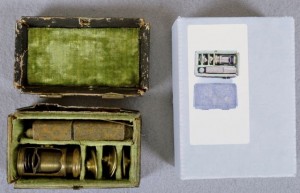
Also in the lab is this Memento Mori, a lovely and delicate ivory carving of a contemplative skeleton who we have nicknamed “Jack.”

HOM isn’t the only collection with fascinating non-book items. Check out this wonderful U.S. patent model of a continuous cigarette rolling machine dating from 1876. It is about two feet long and one foot high, and all the moving parts work.

If you are interested in seeing previous boxing projects, you can check out our Flickr page. Be sure to head over to Parks Library Preservation to see what amazing things they have in their lab.
Quick Pic: The Halloween Edition
 Happy Halloween everyone! To celebrate we would like to introduce you to “Fred” as we have named him. This German anatomical model dates to the 1930’s or 1940’s and is from the History of Medicine Collection.
Happy Halloween everyone! To celebrate we would like to introduce you to “Fred” as we have named him. This German anatomical model dates to the 1930’s or 1940’s and is from the History of Medicine Collection.
Fred comes complete with removable lungs, liver and intestines, just the thing for today’s festivities. Jennifer is figuring out how to build a box for him to keep all his guts in place.
Have a safe Halloween! Watch out for zombies lurching and little children crossing the streets, and brush your teeth after you steal share your kid’s candy.
Quick Pic: Frightening Finds
 Nothing quite gets you thanking your lucky stars that you live in the 21st Century as working with the History of Medicine Collection in the David M. Rubenstein Library.
Nothing quite gets you thanking your lucky stars that you live in the 21st Century as working with the History of Medicine Collection in the David M. Rubenstein Library.
We have been helping to retrofit the boxes containing historic medical instruments in preparation of our move to swing space for the next phase of renovation.
We had a good time playing a game I call, “what in the world is this thing and what body part does it apply to?” Depending on your “ick” tolerance it can be a fun game. Do you want to take a guess at what this is?





